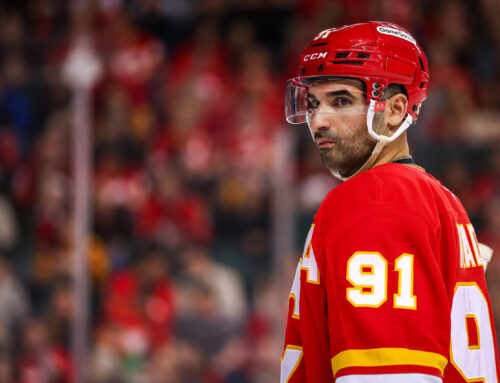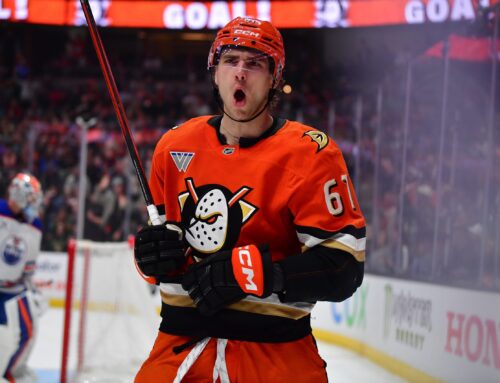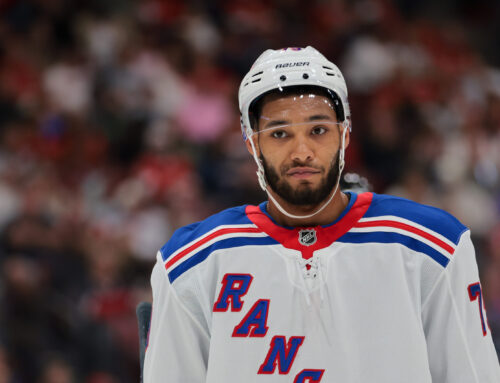One of the things I love about the keeper leagues I participate in is the uniqueness of a couple of rules.
I’ve been in leagues that are straightforward keeper leagues, which are great but always seemed to be lacking something that made them stand out.
I know there are plenty of people who prefer the standard set of rules for their leagues, and there’s nothing wrong with that. Keeping things simple can go a long way to keeping general managers invested in the pool, especially if they aren’t as invested in fantasy leagues as some others.
But if you’re in a league with a lot of hardcore general managers, unique rules can make your league more enticing.
Not sure where to start for unique rules for your league? I asked some fellow general managers in my leagues and scoured the Internet looking for unique rules. As well, Dobber has a column on How to Start a Fantasy Hockey Keeper League, which shows different sets of rules for keeper leagues. Going through the constitutions of those leagues brings forward some distinctive rules.
If you are looking for rules to spice up your league, keep in mind the timing. If you’re in a new league that hasn’t had your draft yet, then you can introduce some unique rules. However, if your league has been around for years, you should hold off on any changes as new rules can mess up any strategies that some general managers have already started for this season.
That said, below are 10 distinctive rules that can make your keeper leagues more enticing.
10. Deciding tiebreakers
Leagues can get as creative as they want when it comes to deciding tiebreakers. However, the clear majority just default to the basic ones, whether it be head-to-head record, goals for or winning percentage. However, Dobber member FirstRoundPick’s league goes about it a different way. You take the last two numbers of the save percentage of the best netminder (minimum 25 games) of each of the teams that have tied and add it to the total point score. As he explained it, if your top netminder finished with a save percentage of .923, you get 23 points added to your final total. If the other GM’s best goalie has a save percentage of .921, then 21 points get added to the tiebreaker. This rule increases the value of top goaltenders as well.
9. Ensuring teams keep a goaltender to prevent tanking
Any team that wants to tank will ultimately turn to their goaltending as a winning goaltender hurts your odds. This is why if your league rules are not carefully written, they could be abused quickly. All too often, fantasy general managers can simply choose not to roster a goaltender. This can create chaos, but will almost guarantee the GM will lose every goaltending statistic in head-to-head leagues. In points-only leagues, having zero goalies will ensure zero points. In one of Dobber’s leagues (described here), there is a rule to prevent that. Failure to own a goaltender on your pro team will result in a blank spot, and every day you have a blank spot, there’s a one-point penalty. If you were without a goalie for 50 days, you lose 50 points if you are a playoff team, but you gain 50 points if you are tanking. No goalie on your roster at the end of the season means an automatic extra 50-point loss for top-five teams and an extra 50 points added if you’re tanking.
8. Double-checking a departing GM didn’t favor his buddies
We’ve all been there. You’re in too many fantasy leagues, you have kids, family life gets in the way, or maybe there’s just a league you don’t like. Most leagues will have turnover occasionally, but you want to make sure anyone who leaves didn’t purposely mess up his team or unfairly beef up another team. That’s why Dobber’s league mentioned above has a unique rule to prevent that. Any owner who quits the pool at the end of the season will have their last two trades investigated. If either of the two trades is deemed unfair by a percentage of the GMs, the other team involved will lose some (or all) of their draft picks. This ensures the competitive balance of the league doesn’t go out of whack by an exiting GM.
7. Preventing dynasties
Sometimes, it can be quite boring for a fantasy league to have a dynasty and some leagues will have rules to punish those who are successful. One league, with the rules listed here, limits the number of protected spots based on how you finished. If you finish first, you can only protect five players. If you come second, you protect six. And so on, until the team that finishes sixth can protect 10. Then the bottom teams can pick from the players that were unprotected by the top teams (although there are limits on how many those teams can lose). This ensures the top teams will lose at least one of their top six or seven players, and speed up the rebuild of a tanking team.
6. Trading points
Trades are one of the greatest things about fantasy keeper leagues. If you’re going for the win, you trade for players having career years. If you’re rebuilding, you trade for prospects, draft picks and young players. In my points-only league (where the top eight forwards, five defensemen and two goalies count in your final standings), you also trade for the points a player has already acquired that season. That means you’re not just trading for what a player will do, you’re trading for what they’ve already done that season. Look at Erik Karlsson as an example. By January 18 of last season, Karlsson already had 62 points in 46 games. In most leagues, if you bought high on him at that point of the season and he got injured six seconds into his first shift of the next game and was out for the season, you were done. In this league, his 62 points still count for you. This gives a player extra value in trades, but also encourages GMs to trade players having career years. It also means a team that is 150 points out at Christmas can make some shrewd trades and be back in contention by Valentine’s Day.
5. Containing tanking
Most leagues will have rules to prevent tanking, but there are ways to make it more unique. One of my leagues ties the odds into the NHL draft lottery. If you were the fourth-worst team, your odds line up with the fourth-worst NHL team. However, one of the more ingenious ideas is to tie the draft lottery into the NHL playoffs. A 10-team league that Dobber forum member evans334 participates in sees the 10th and ninth worst teams receive five picks each, while the eighth and seventh get three picks apiece (these picks are tradeable). Those bottom four GMs have a draft where they choose an NHL playoff team with each pick. This means a fantasy GM may wind up with Boston, Tampa, Minnesota, Vegas and the Islanders. If any of those teams win the Cup, that GM gets the first overall pick. In evens334’s league, eventual cup winner Golden Knights was the 14th pick out of 16 teams in this year’s draft. It doesn’t matter how poor your fantasy team was, it’s how confident you are in your ability to predict the NHL postseason.
4. Adding value to dropped players
This one comes from my points-only keeper league mentioned earlier. We keep 15 players plus two rookies. All dropped players are put into an auction, but you bid on players using your draft picks. For example, if you drop Bryan Rust, I could bid my 46th overall on him. Then someone outbids me by placing their 42nd pick on him, and someone else then bids their 29th overall pick. The GM who bids the highest draft pick gets the player, but the draft pick goes to the general manager who dropped the player. This adds some extra wrinkles to one’s strategy. Do you want to bid a high draft pick on a player who was dropped by your top competition? Do you drop players that may be slightly better than some of your keepers because that may net a better draft pick? Is the 20th overall draft pick more valuable than anyone in the auction? Last year, the highest auction pick was used on Claude Giroux (23rd overall), and 13 players were won at auction.
3. Deciding keepers
For most leagues, deciding which players to keep is always a tough decision, but it’s pretty easy to know you’re going to keep your studs. There are leagues out there that try to prevent this. The most common type of rule regarding this is to put a limit on how long you can have a certain player (i.e. – you can only keep a player for five years before they are returned to the draft, so you know Connor McDavid is available at least three or four times in his career). However, Dobber member Dr. Brad is in a league with a different twist. You can only keep two of your top four players, and four of your next top six, based on Yahoo’s end-of-season rankings. If you wind up with Nathan MacKinnon, Cale Makar, David Pastrnak and Jack Hughes on your team and they are your top-four players, you are losing two of them for sure. This helps make the draft more exciting as there are always top players available and increases the value of draft picks.
2. Helping new GMs not suck
In my points-only 12-team league, if a GM leaves, we have a dispersal draft of that team’s players. One pick per team, the worst team gets first overall, etc. Then when a new team joins, they pick from the remaining players, plus all the other dropped players until they get to 17 players. This isn’t ideal, as it creates a pretty pathetic team that will take a few years to be competitive. In my other 24-team league, it’s handled a different way. Any new GMs will take over a team and participate in a dispersal draft, but all other current GMs are offered the opportunity to join the dispersal draft as well. If a current GM participates, the players on their team are added to the dispersal draft. There is no limit on how many current teams can participate. This prevents the incoming GM from getting a poor team, but it also prevents that GM from having a powerhouse team without really having “earned” it. This past summer, we had two new GMs and one veteran GM who joined in on the dispersal draft.
1. Getting more value through trades
The Keeping Karlsson crew has a series of leagues under the umbrella of the Keeping Karlsson Ultimate Patron Fantasy League. One of the unique rules in this league consists of the ability to counteroffer, and it is brilliant. Any time a trade is announced, all managers have 24 hours to make a better offer for either side of the deal, but it must include the exact same players. If someone makes a better offer, the two original GMs can go back to discuss potentially a better deal. From the KKUPFL Fantasy Hockey League website:
1. Brian trades Karlsson to Patti for Zibanejad
2. Patti is approached with a counter offer from Elan
3. Patti goes to Brian to let him know that she’s going to accept the counter from Elan unless Brian wants to offer more for Zibanejad
4. Brian and Patti agree on a new package where Brian will now give Karlsson + Hyman for Zibanejad.
5. The initial trade is canceled and Brian and Patti put in the new trade.
This is a great rule. How many times in your league do you see a trade announcement and think “I could have made a better offer if only I had known that player was available?” Now you can. It also prevents GMs from making bad deals, as any bad trades will be countered pretty quickly by other GMs looking to grab those players.
5 Comments
Leave A Comment
You must be logged in to post a comment.





 TOR
TOR EDM
EDM ANA
ANA PIT
PIT BUF
BUF S.J
S.J MIN
MIN DET
DET CBJ
CBJ UTA
UTA NYR
NYR

We do contract years in my league. We have 12 teams with rosters of 18, you get 15 years to give out however you see fit. One guy for 15 years or 1 year to 15 guys and anywhere in between. You also keep the player where you drafted them so the draft and sleepers change the value of the players. Free agents start at the 8th rd and slide if you have someone there already. We also do a lottery for the bottom six to prevent tanking.
I love that idea with the 15 years. It’s brilliant, and different.
For deciding keepers, we total the points of the best seven players from last season’s top team. That becomes the “points cap” and every team can protect as many players as they want so long as the total points of the players they protect (based on points from the previous season) does not exceed the points cap. If you acquire a 100 pt player late in the season, it still counts as 100 pts when it comes time to protect that player. If you have a star player who is injured (think Kucherov a couple of seasons ago as an extreme example) then you get to keep them at a deep discount. Everyone seems to like this approach.
That’s really neat. Injured players must see a massive increase in value (like Werenski last season) after they get injured.
If my best goalie’s SV% was 0.893, would I add 93 points and win over the guy who has the .921 goalie??? Someone either didn’t think this through, or the explanation is incomplete.